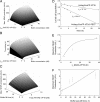A synthetic time-delay circuit in mammalian cells and mice
- PMID: 17296937
- PMCID: PMC1796999
- DOI: 10.1073/pnas.0606398104
A synthetic time-delay circuit in mammalian cells and mice
Abstract
Time-delay circuitries in which a transcription factor processes independent input parameters can modulate NF-kappaB activation, manage quorum-sensing cross-talk, and control the circadian clock. We have constructed a synthetic mammalian gene network that processes four different input signals to control either immediate or time-delayed transcription of specific target genes. BirA-mediated ligation of biotin to a biotinylation signal-containing VP16 transactivation domain triggers heterodimerization of chimeric VP16 to a streptavidin-linked tetracycline repressor (TetR). At increasing biotin concentrations up to 20 nM, TetR-specific promoters are gradually activated (off to on, input signal 1), are maximally induced at concentrations between 20 nM and 10 microM, and are adjustably shut off at biotin levels exceeding 10 microM (on to off, input signal 2). These specific expression characteristics with a discrete biotin concentration window emulate a biotin-triggered bandpass filter. Removal of biotin from the culture environment (input signal 3) results in time-delayed transgene expression until the intracellular biotinylated VP16 pool is degraded. Because the TetR component of the chimeric transactivator retains its tetracycline responsiveness, addition of this antibiotic (input signal 4) overrides biotin control and immediately shuts off target gene expression. Biotin-responsive immediate, bandpass filter, and time-delay transcription characteristics were predicted by a computational model and have been validated in standard cultivation settings or biopharmaceutical manufacturing scenarios using trangenic CHO-K1 cell derivatives and have been confirmed in mice. Synthetic gene circuitries provide insight into structure-function correlations of native signaling networks and foster advances in gene therapy and biopharmaceutical manufacturing.
Conflict of interest statement
The authors declare no conflict of interest.
Figures



Similar articles
-
A novel vector platform for vitamin H-inducible transgene expression in mammalian cells.J Biotechnol. 2007 Aug 31;131(2):150-8. doi: 10.1016/j.jbiotec.2007.06.008. Epub 2007 Jun 23. J Biotechnol. 2007. PMID: 17669538
-
Vitamin H-regulated transgene expression in mammalian cells.Nucleic Acids Res. 2007;35(17):e116. doi: 10.1093/nar/gkm466. Epub 2007 Sep 7. Nucleic Acids Res. 2007. PMID: 17827215 Free PMC article.
-
Macrolide-based transgene control in mammalian cells and mice.Nat Biotechnol. 2002 Sep;20(9):901-7. doi: 10.1038/nbt731. Epub 2002 Aug 19. Nat Biotechnol. 2002. PMID: 12205509
-
Mammalian synthetic biology: engineering of sophisticated gene networks.J Biotechnol. 2007 Jul 15;130(4):329-45. doi: 10.1016/j.jbiotec.2007.05.014. Epub 2007 May 24. J Biotechnol. 2007. PMID: 17602777 Review.
-
Recent advances in mammalian synthetic biology-design of synthetic transgene control networks.Curr Opin Biotechnol. 2009 Aug;20(4):449-60. doi: 10.1016/j.copbio.2009.07.009. Epub 2009 Sep 15. Curr Opin Biotechnol. 2009. PMID: 19762224 Review.
Cited by
-
Multi-chromatic control of mammalian gene expression and signaling.Nucleic Acids Res. 2013 Jul;41(12):e124. doi: 10.1093/nar/gkt340. Epub 2013 Apr 26. Nucleic Acids Res. 2013. PMID: 23625964 Free PMC article.
-
Emerging biomedical applications of synthetic biology.Nat Rev Genet. 2011 Nov 29;13(1):21-35. doi: 10.1038/nrg3094. Nat Rev Genet. 2011. PMID: 22124480 Free PMC article. Review.
-
Transplantability of a circadian clock to a noncircadian organism.Sci Adv. 2015;1(5):e1500358. doi: 10.1126/sciadv.1500358. Sci Adv. 2015. PMID: 26229984 Free PMC article.
-
Mammalian synthetic biology: emerging medical applications.J R Soc Interface. 2015 May 6;12(106):20141000. doi: 10.1098/rsif.2014.1000. J R Soc Interface. 2015. PMID: 25808341 Free PMC article. Review.
-
A red/far-red light-responsive bi-stable toggle switch to control gene expression in mammalian cells.Nucleic Acids Res. 2013 Apr;41(7):e77. doi: 10.1093/nar/gkt002. Epub 2013 Jan 25. Nucleic Acids Res. 2013. PMID: 23355611 Free PMC article.
References
-
- Endy D. Nature. 2005;438:449–453. - PubMed
-
- Gibbs WW. Sci Am. 2004;290:74–81. - PubMed
-
- Hasty J, McMillen D, Collins JJ. Nature. 2002;420:224–230. - PubMed
-
- Sprinzak D, Elowitz MB. Nature. 2005;438:443–448. - PubMed
-
- Guido NJ, Wang X, Adalsteinsson D, McMillen D, Hasty J, Cantor CR, Elston TC, Collins JJ. Nature. 2006;439:856–860. - PubMed
Publication types
MeSH terms
Substances
LinkOut - more resources
Full Text Sources
Other Literature Sources

